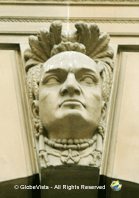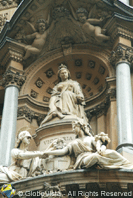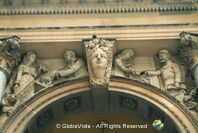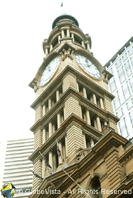 The Sydney General Post Office stands in all its glory (and controversy) at 1 Martin Place, the centre of Sydney’s Central Business District.
The Sydney General Post Office stands in all its glory (and controversy) at 1 Martin Place, the centre of Sydney’s Central Business District.
The building is one of Colonial Architect James Barnet’s finest creations and is a great example of Victorian Free Classical style. Barnet was inspired by the Palazzi Comunali, the splendid public buildings of Renaissance Italy.
The building was constructed in various stages from 1866 to 1891, replacing a smaller post office which had occupied the site in the 1830s.
Barnet drew up the plans for the GPO in 1865 with work commencing in 1866. The first phase was completed in 1874, with most of the work being done by the builder, John Young. The building was later extended to Pitt Street under the close direction and design of Barnet.
In the 1890s extensions were added but it would be under Barnet’s successor, W.L.Vernon. Further additions continued well into the 1900s.
During World War II the GPO was seen as a prime target for attack by the enemies. As a result, the clock tower was temporarily removed.
In the 1980s the building had to be closed in the interest of the public as it was no longer considered safe.
Following its closure, extensive alterations began in 1997 with work done to the postal hall and the grand staircase. Additional buildings were added including offices and a 31 storey hotel at the rear of the building.
In 2000 a small section of the building was once again opened as a post office.
Features of the GPO
Barnet, who was inspired by the grand public buildings of Renaissance Italy, took a great deal of care and a lot of money in creating his own masterpiece. The building walls were constructed from Pyrmont sandstone. The arcades featured polished grey granite columns with carved Corinthian capitals in sandstone.
The essence of his design was centred around the decorative carvings which adorned the facades. Many of the carvings were created in Italy by Italian craftsmen, from the designs of Australian/Italian sculptor, Tomaso Sani.
Central Carvings
 The central carving of the New South Wales Coat-of-Arms was carved from one block of stone. The three central features of the main arch are the Royal Arms of Great Britain and Ireland, two symbolic female figures stretching towards each other represent Britannia and New South Wales and above them a seated Queen Victoria in her full dress.
The central carving of the New South Wales Coat-of-Arms was carved from one block of stone. The three central features of the main arch are the Royal Arms of Great Britain and Ireland, two symbolic female figures stretching towards each other represent Britannia and New South Wales and above them a seated Queen Victoria in her full dress.
The carvings were created in Italy from Sicilian Marble by Italian sculptor, Signor Giovanni Fontana. The carvings were made from designs specially approved by Barnet.
You may notice above the Queen’s head the two winged cherubs, Heralds of Fame, holding a laurel wreath over her head. On either side of Queen Victoria are the twenty-four faces of the GPO representing Continents, Countries, and states of the British Empire.
Carvings
 Around the arches of the building are carvings of symbolic figures representing the Arts, Science, Agriculture and Commerce.
Around the arches of the building are carvings of symbolic figures representing the Arts, Science, Agriculture and Commerce.
On the keystones are heads representing Neptune, Jupiter, Saturn, Mercury and Minerva.
Also around the building are carvings of Queen Victoria, the Prince of Wales and the Duke of Edinburgh.
If you look hard enough around the building you can find carvings of well-known explorers such as Captain Cook, La Perouse, Tasman, Columbus, and Vasco da Gamma.
Also included in the carvings are four of New South Wales governors, Sir John Young, the Earl of Belmore, Sir Hercules Robinson and Lord Loftus.
The George Street and Martin Place facade carvings were free of controversy in fact they were highly regarded. It was those Pitt Street bassorievo’s which attracted all the attention and criticism.
For more info Public Art Around The World
Controversy
In 1882 Barnet had requested a costing from McCredie Brothers for a series of carvings to be placed in the spandrels of the arches. The carvings were to represent professions and trades from everyday life. Barnet believed the Post Office, being a public utility, should have carvings representing the life of everyday workers, professionals, and tradesmen.
The commission of creating the carvings went to Italian sculptor Tomaso Sani. Unfortunately, following the viewing of the carvings, the general consensus of the day was that they were considered crass and caricature-like and something that should never be displayed on such a building of grandeur. In other words, they were modestly realistic representations depicted in a style ordinary people could understand and therefore not worthy.
This case of architectural snobbery caused bitter debate amongst politicians and the establishment who used the press to attack Barnet. It wasn’t long before there was a move in the Legislative council to remove the carvings.
The Chief Justice commented that Barnet should have “consulted gentlemen of taste and judgment in art”. They even went so far as to set up a board to decide on the carving’s fate. As you would expect the report came back condemning the carvings and recommending their immediate removal. Barnet, not one to be bullied by authority sent a letter of rebuttal. It seemed the issue had come to a stalemate.
In 1884 a further attempt to have the carvings removed was made when the issue was referred to the President of the Royal Academy in London. It would take another three years before the Legislative Assembly finally voted for the carvings to remain.
Ironically, today thousands of people walk past the building hardly even giving them a second glance.
But Wait There’s More
A few years ago a rumour spread that one of the carvings on the GPO was that of Italian revolutionary hero, Giuseppe Garibaldi. As it was common (as it still is today) for artists to leave their “mark” on their work, all focus turned to sculptor Tomaso Sani. After a little digging, it was discovered that Sani was working in Florence at the same time Garibaldi was in the midst of widespread popularity in Italy. This was at a time when Italy was heading for the Unification of the Italian States. So was Garibaldi ever found?
Rumours persisted and eventually, a tiny image on the side of the “Italy” head was identified as an image of interest! Some believe it is in fact Garibaldi yet others believe it is an image of Barnet kneeling to write his name on the building. You be the judge!
The Tower Must Go

In 1941 during the Second World War great concerns were held for the GPO especially its vulnerability from aerial attacks by the Japanese. The Post Office was one of the key communication centres of the city and equipped with vital communication equipment, which was seen as a priority target for the enemies.
In 1942 the decision was made to remove the clock tower. The laborious task of dismantling the 1,500 tons (1,530 tonnes) stone structure was undertaken by various government departments. Each stone was removed, numbered, and listed using the original 1890s plans. The stones were then placed into storage.
When the tower was finally dismantled all the key parts were stored throughout Sydney, the clock was at the Government Stores depot (Mascot), the bells were at a Storage facility at Sydenham and the iron & masonry found itself at the Maroubra Telephone Exchange. With the clock tower gone the GPO (like all the buildings in the CBD) was completely blacked out for the duration of the war including the glass roof lights.
By the time the war had ended little was thought of rebuilding the tower in fact it would take nearly two decades and great public pressure before the government finally and reluctantly proceeded in the restoration of the clock tower and the GPO in 1963.
Interesting facts about the GPO
Local Sydneysiders were constantly warned not to strike their wax matches along the marble columns when smoking because it left unsightly marks. If you look closely you may even see some of the marks still left there after the restoration of the building.
The NSW mileage is measured from the GPO.
